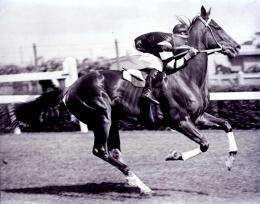Hair analysis proves it: Legendary racehorse Phar Lap died of arsenic poisoning in 1932

(PhysOrg.com) -- Phar Lap was a legendary racehorse that won many notable races. After its triumph in the famous Agua Caliente Handicap in 1932 in Mexico, the animal died in agony under mysterious circumstances while on tour in the USA. One of the suggestions at the time was that Phar Lap had been poisoned.
Ivan M. Kempson (Academia Sinica, Taiwan) and Dermot A. Henry (Museum Victoria, Australia) have now subjected the horse’s hairs to a very thorough examination. As the researchers report in the journal Angewandte Chemie, the animal does indeed seem to have died of arsenic poisoning.
Traces of many substances that enter the body eventually also wind up in the hair, where they accumulate. Hair analysis has often been used to detect drug use or to posthumously uncover poisoning as the cause of death. After his death, Phar Lap was prepared and stuffed and displayed in Museum Victoria in Melbourne. “We were able to obtain small pieces of the hide and mane with the roots intact,” reports Kempson. They only examined hairs that were unquestionably still growing at the time of death. These were individually analyzed along their entire length with synchrotron X-ray fluorescence spectroscopy at the Advanced Photon Source in Chicago. This method detects even trace amounts of chemical elements because each element emits very characteristic radiation.
The scientists looked at the arsenic content of the hairs. “They found a small amount of arsenic that was relatively evenly distributed over all of the hairs. This is in agreement with the arsenic content of the chemicals used to preserve the hide,” says Kempson. “In addition, we found a considerably elevated arsenic content at the same distance from the root in each of the hairs we examined.”At the time of the horse’s death, this part of the hair was under the surface of the skin.
“If you take into account the rate of growth for horse hair and the metabolic rate, the location at which the elevated arsenic concentration was found indicates that the horse must have eaten and metabolized the arsenic,” explains Kempson. In addition, the scientists used an X-ray technique that can distinguish the chemical environment of the arsenic. Says Kempson: “ The arsenic species identified also suggest that Phar Lap died of arsenic poisoning.”
However, it is impossible to know how the horse ingested the arsenic. Was it deliberate poisoning by competitors or enviers? Was it an accident—perhaps an overdose of the arsenic-containing tonics popular at the time? Was the feed contaminated? “That will always remain a mystery,” says Kempson.
More information:
Ivan M. Kempson, Synchrotron Radiation Reveals Arsenic Poisoning and Metabolism in Hair: The Case of Phar Lap,
Angewandte Chemie International Edition, dx.doi.org/10.1002/anie.200906594
Provided by Wiley
















